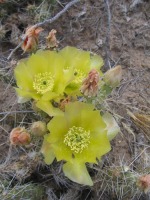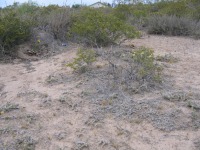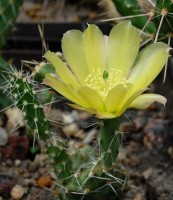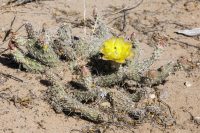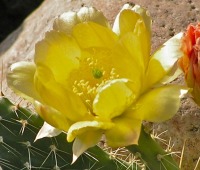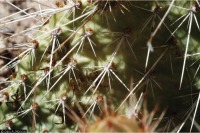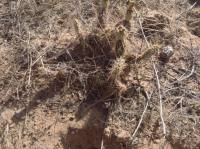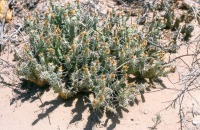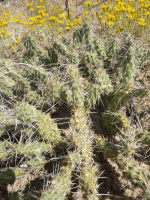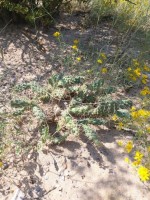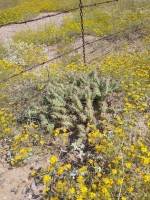
Engelmann, Proceedings of the American Academy of Arts and Sciences 3: 301, 1856/1857
Lectotype; Isotype; Herbarium; Herbarium; Herbarium; Herbarium
Original Citation
What is Opuntia arenaria?
O. arenaria is a small pricklypear that occurs in the greater El Paso region from adjacent New Mexico to near McNary, Texas, in sandy or silty soils where they form low, creeping cactus mats often 0.5-2 m in diameter. It may be 15-30 cm tall. It has a broader distribution in Mexico. It is described as a variety of O. polyacantha in the Flora of North America (Pinkava) and by Powell and Weedin (2004). However, we regard this cactus as a stand-alone species of pricklypear.
See GenBank locus JF787339.1.
The Details
From Powell and Weedin (O. polyacantha var arenaria):
Often some branches of this Opuntia are buried by shifting soil and these have been interpreted by some to be rhizomes. The pads are small and narrow, 4-7(-10) cm long and 2-3(-5) cm wide and 2-3 cm thick. This Opuntia produces spines in all but the lowermost areoles, but the spines do not cover the glaucous or light green stem segments. Areoles may have 5-10 spines with one much longer than the others. The largest and flattest pads of O. arenaria may resemble the pads of O. polyacantha in the overall aspect, but they are always smaller.
The yellow flowers of this pricklypear are 4-6.4 cm long and 4-6 cm wide. The filaments are white or pale tinged with pink, anthers are 1.5 mm long and yellow. The style is white or pale green, 1.2 to 2 cm long. The stigma lobes are about 2 mm long and green. The pericarp is slender, perhaps 2 or 3 times as long as thick.
The fruits are reddish and then tan and dry at maturity in this Opuntia. Fruit areoles may have 3-6 spines that are 6-9 mm long. The fruit is narrowly obovate-obconic, constricted below the apex, 2.5-3 cm long, and 0.9-1.2 cm in diameter. The umbilicus is deep. Seeds are tan and shiny, irregularly discoid, and large—up to 6.5 mm in diameter. They have a 1-2 mm margin.
O. arenaria is diploid.
Other Notes
This pricklypear species is closely akin to other dry-fruited species of Opuntia, but due to its low chromosome number and morphological stability, it is usually considered to be a distinct and well-defined species. O. arenaria is separated from the larger Opuntia polyacantha varieties because the pads in O. polyacantha are usually well over 5 cm across, as well as the fact that occasional individuals of that taxon may have pink, red, or magenta pigmentation in their flowers. Opuntia polyacantha is tetraploid (2n = 44), whereas O. arenaria is diploid (2n = 22). The two Opuntias are not known to occur sympatrically.
For more information, see:
Root glochids and root spurs of Opuntia arenaria (Cactaceae), Boke, 1979

